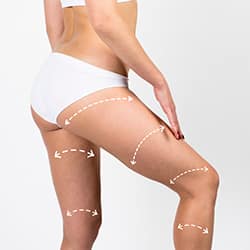Subcision Surgery: A Minimally Invasive Marvel for Cellulite Removal

Learn more about the essential aspects of subcision cellulite removal, a minimally invasive plastic surgery procedure that targets the root causes of cellulite.
Understanding Cellulite
Cellulite occurs when connective tissue bands, known as fibrous septa, become taut and pull the skin’s surface down, creating dimples and depressions. These septa are like the threads in a quilt, connecting the skin’s surface to deeper layers. When fat cells push against these bands, the skin ripples, resulting in the appearance of cellulite.
Factors such as genetics, hormones, and lifestyle habits can influence cellulite formation. Cellulite often appears on the thighs, buttocks, and sometimes the abdomen, making it a common aesthetic concern for many individuals.
Subcision Surgery: How It Works
Subcision surgery is a minimally invasive procedure designed to target the root causes of cellulite by releasing the fibrous bands responsible for skin dimpling. Here’s how the procedure works:
- Consultation – The journey begins with a personalized consultation. During this consultation, the practitioner evaluates your cellulite concerns and discusses your goals to determine if subcision is the right choice for you. Subcision works best in smaller, scattered areas of dimpling. When there are smaller areas subcision can release the tethering ligaments without affecting the surrounding skin. This will minimize skin drooping. Areas with higher density of dimples are reliant on these fibrous bands to help hold the skin in place. Release of these bands can lead to excess skin drooping.
- Local Anesthesia – At the start of cellulite removal surgery, the treatment area is typically numbed with local anesthesia to ensure your comfort throughout the process.
- Micro-Incisions – Small, discreet incisions are made in the skin’s surface at strategic points where cellulite is present. These incisions are minimal and leave little to no visible post-surgical marks.
- Subcision Technique – A specialized cannula or needle is inserted through the incisions to gently release the fibrous bands causing the cellulite. This allows the skin to become smooth again.
- Minimal Downtime – Subcision surgery is minimally invasive, and most patients can return to daily activities within a day or two. Moderate swelling and bruising may occur but are typically manageable with compression garments.
- Gradual Improvement – While some results may be visible shortly after the procedure, the full benefits of subcision surgery become more apparent over time as the skin heals and collagen production is stimulated. Patients typically notice progressive improvements in the texture and appearance of their skin.
Subcision Surgery Aftercare
Post-treatment care following subcision cellulite removal is generally uncomplicated. Patients may be advised to wear compression garments to alleviate swelling, minimize bruising, and facilitate the healing process. Additionally, pain medications and antibiotics may be prescribed to manage any discomfort and minimize the risk of infection.
By diligently following all of the surgeon’s activity restrictions and guidelines for care and follow-up appointments, patients can significantly impact the healing process and minimize the visibility of post-surgical marks.
Contact Us Today to Learn More!
Thank you for joining us for these insights on addressing cellulite with minimally invasive subcision cellulite removal surgery. Stay tuned to this blog as the aesthetic experts at Chesterfield Plastic and Reconstructive Surgery regularly explore the body sculpting procedures and aesthetic treatments that we offer.
A consultation for subcision cellulite removal is the first step to learning more about this effective treatment. Contact Chesterfield Plastic & Reconstructive Surgery today to arrange your appointment!



